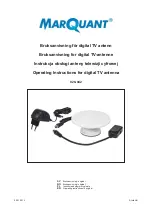
readout should increase for CW and decrease for CCW. If these tests give incorrect results, refer to
the troubleshooting section of this manual. If the results are correct, test full rotation to the electronic
limits in both CW and CCW directions. When this test has been performed turn the rotator to 000
degrees with the leverl switches. Then test the preset feature by setting a new direction with the preset
knob. Observe that the rotator will turn to that position and stop. The optimiser feature will ensure that
travel to the preset position is always in the shortest manner.
2.6 Troubleshooting
-
Power
- Check the presence of the house power at power outlet;
- Check that the power cable plugs is correctly connected.
- Check the fuse. If it’s blown, replace it with one of the correct value and switch power on. If it
blows again, the user contacts the local service agent.
-
Motor turns in the wrong direction
-
If while you were pushing CW switch the rotator started in counter clock wise sense, then the
motor is getting reversed DC polarity. Change over the motor wires.
-
Rotator follows the right CW and CCW commands but display shows the opposite.
- With a digital voltmeter, check the presence of +5Vdc on the motor board, lead no. 4
If +5Vdc is not there, check the rotator cable connections/continuity.
- Display shows 110. and rotate only CW.
Potentiometer is misaligned, check the resistence as in the “truth table” if the resistence
valoue is lower than what it should be, than rotate the rotator CW till you get the right
resistence valoue.
- Display shows 250. and rotate only CCW.
Potentiometer is misaligned, check the resistence as in the “truth table” if the resistence
valoue is higher than what it should be, than rotate the rotator CCW till you get the right
resistence valoue.
2.7 Rotator installation
Before drilling holes in the mounting plate, place the rotator inside the tower and adjust its
position so there will be no interference between rotator body and tower.
Put the antenna mast inside the mast clamp and lock centrally. The centre axis line must be within
0.5° of true.
By a pen, mark the position of the mounting holes on the mounting place, remove the rotator, and
drill the holes .
Use the four bolts with washers and self-locking nuts to secure the rotator on the mounting plate.
Before tightening the bolts, insert the antenna mast in mast clamp, turn the rotator for 1 revolution
and adjust its position until the central axis line is within 0.5° . Now tighten the bolts.
Note: Keep you rotator base dry, make sure that your tower rotator plate has enough
dreinage holes. Your rotator could get moisture in the base bell from the water standing on the
plate. If your tower rotator plate doesn’t have drainage holes and you can’t drill some, than put
some washers between the rotator base and the tower rotator plate.
2.8 Antenna direction adjustement
Antenna rotator alignement is mechanical. After the antenna is installed on the mast, turn
rotator to the desired bearing. Unlock the bolts on mast clamp and with a magnetic compass turn the
antenna mast until the antenna beam direction is like that shown on the rotator control box. Lock the
antenna mast with the mast clamp bolts. The antenna beam direction now is fixed. If you want to
change it, you must rotate the antenna clamp on antenna mast. See Calibration Offset issue.
2.9 Rotator maintenance
The worm-geared motors are lubrificated for life and no maintenance is required. If you live in
an industrial zone or sea area, after a time you may have some corrosion to the outer casing. Rotators
are coated with anticorrosive paint at the factory and if repainting is necessary, use ordinary
anticorrosive paint for ferrous metal.
10







































